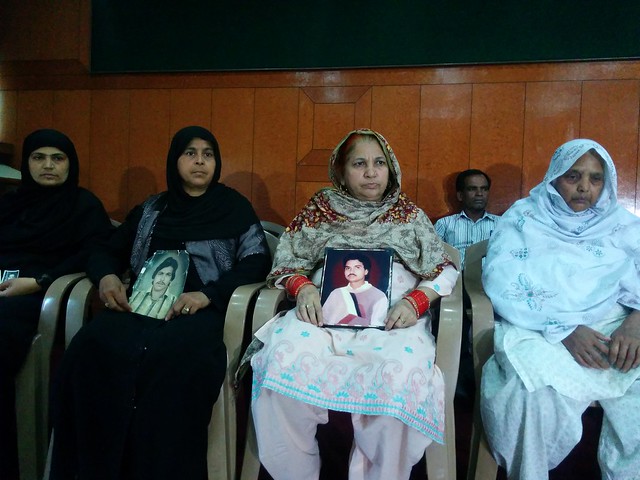By M Reyaz, TwoCircles.net,
New Delhi: “Men from Hashimpura between ages 12 to 50 were segregated, forced in a truck and taken to so remote place in the dark of the night. One by one PAC shot at us. A bullet hit me here in the stomach and exited from back,” says Mohammad Usman, while showing the bullet mark that has remained.
Zaibun Nisa, whose husband was brutally murdered on that fateful night, along with over 40 others on May 22, 1987 by the Uttar Pradesh Provincial Armed Constabulary in the infamous Hashimpura Massacre, says, “We fought for 28 years despite all difficulties for justice, but all in vain,” adding, “We will not give up, but will continue to fight till we are alive.”

Zaibun Nisa, whose husband was killed in the infamous Hashimpura Massacre, sharing her harrowing tale.
Sixteen Provincial Armed Constabulary (PAC) personnel were acquitted by a court in Delhi on Saturday, March 21, in the 1987 Hashimpura massacre case. A total of 19 PAC personnel, three of whom have since died, were facing trial for allegedly killing 42 people in Hashimpura Mohalla of Meerut in Uttar Pradesh on May 22, 1987.
Witnesses in the case, those who survived the bullets and police atrocities, as well as the kins of the deceased shared their harrowing tales on Tuesday, March 24 at a public meeting held in the capital’s Indian Social Institute. Advocate Vrinda Grover, her colleague and counsel in the case Advocate Rebecca M John, Wajahat Habibullah, Justice (retd) Rajinder Sachar, Professor Kamal Mitra Chenoy, John Dayal, Professor Apoorvanand, Harsh Mander and Tapan Bose among others also spoke on the occasion, sharing their shock and disappointment over the judgement.

Usman, Hashimpura Massacre survivor, showing his bullet mark.
Of about 50 odd men taken in the truck, five of them mysteriously survived, although they still carry the wound of bullets in them. Zulfikar Nasir, who was 15 years old at the time of the incident (now 42), still remembers that harrowing night vividly. He says that the first person whom the PAC jawan killed was Yaseen from his colony followed by Ashraf; Zulfikar’s turn came third. “It was dark, two policemen held me while the third shot at me. They then threw me in the canal, taking me to be dead,” he said, adding, “By God’s grace, I was alive but did not move and held on to weed in the canal.”
After PAC went away, he moved, though in pain, and saw Kamruddin, his neighbour, soaked in blood. “Somehow I pulled him out but he was in pool of blood and asked me to go as he would anyway not be able to survive,” he says, adding, “I then ran away to save my life, some locals helped me reach the local hospital.”
Some of those killed in the massacre were from Bihar, who used to work in different looms in Meerut. Two of those who survived and were witnesses in the case are originally from Darbhanga district in Bihar. Mujibur Rahman was lucky to survive, but he lost one of his uncles and a brother that fateful night. Babuddin still breaks into tears as he remembers how mysteriously he survived.

Advocate Vrinda Grover, with Zulfikar Nasir, Mujibur Rahman, Mohammad Usman and Babuuddin at ISI in Delhi.
Zaibun Nisa remembers how army personnel had come and picked her husband, the last time she saw him. “He was murdered by PAC. I could not see his dead body, but my brother in law went to identify his dead body,” she remembers, adding, “Police had not handed over the dead bodies to perform the last rites, saying it would create the law and order problem.”
Advocate Vrinda Grover, who has been fighting the case on behalf of the kin of victims, pointed out, “They remembered this in 1987, but not in 2002 in Gujarat when the charred bodies of Karsevaks were taken in open truck or in 2008 in Kandhamal when Swami Lakshmanananda’s body was carried.”
Naseem Bano is one of the four sisters, whose only brother Shiraz was killed. She breaks into tears as she talks about her struggle hoping to get justice one day.
Zareena, whose husband and son was taken by the PAC that day, says, “We waited for 28 years for justice, but are now once again shattered at the court judgement,” adding, “The judgement has rubbed salt on our wounds.”

Naseem Bano, Zaibun Nisa, Zareena and Anjum, whose close relatives were killed in the Hashimpura Massacre.
Anjum, another widow from Hashimpura, says, “My father in law fought for justice for 25 years, but he could not take any longer and committed suicide few years back,” she says, adding that she has to take care of her elderly mother in law as well.
Jamaluddin, father of Kamruddin, who too was killed, is a dejected man now. He does not even want to talk about the judgement and has little hope left.
Compensation: The victims and kin of those killed did not even get adequate compensation, forget justice. Zaibun Nisa sayd,”We got two instalments of twenty thousands and latter in 2008, 4 lakh 60 thousand rupees. But the money was divided among our relatives.”
Advocate Vrinda Grover clarifies, “Generally the State is required to give compensation for its failure to protect its citizens, but in 2008 instead of directly distributing the compensation, it was channelled through the Muslim Personal Law Board, who decided to disperse the money in compliance of Sharia laws, distributing the money among close relatives.”
Adds Usman, breaking into tears, “My father had a loom of his own, today I sell fruits on street.”
Related:

